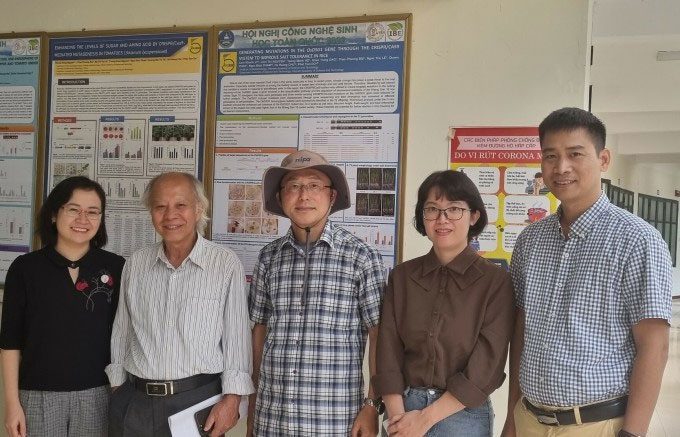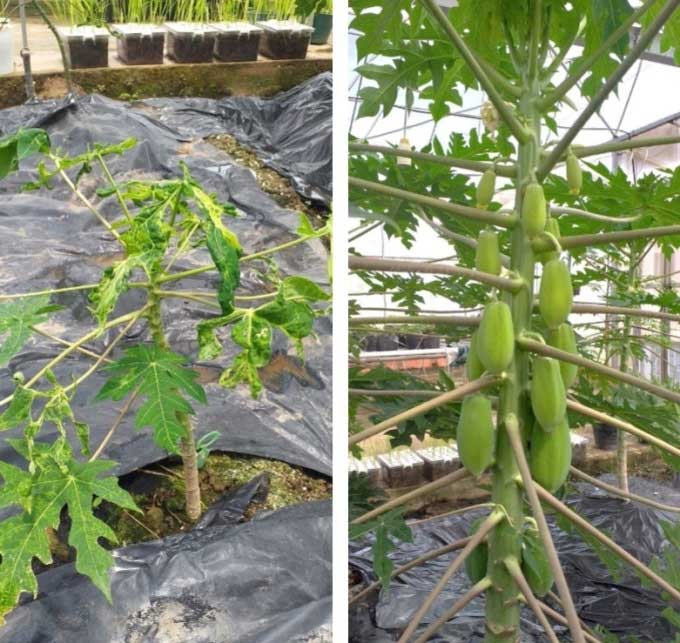This is the first time in the world that the eIF4E gene in papaya has been successfully edited, demonstrating superior resistance to the ring spot virus.
One of the most harmful diseases affecting papaya has been addressed by scientists at the Institute of Biotechnology (IBT), Vietnam Academy of Science and Technology, using gene editing technology through the CRISPR/Cas9 system. This is the result of years of research, starting in 2016, as part of a collaboration between IBT and the University of Edinburgh, United Kingdom, along with research projects from the Royal Society of the UK and various foundational and selective projects at the Institute of Biotechnology.
Dr. Do Tien Phat, a representative of the research team at the plant cell technology department, stated that gene editing using CRISPR/Cas technology has been successfully developed and applied to many plant species, including papaya. However, there have been no reports worldwide on gene editing through the CRISPR/Cas system to enhance resistance to the ring spot virus in papaya. “Our research has initially succeeded in creating papaya plants resistant to the ring spot virus through the CRISPR/Cas9 system,” Dr. Phat said.

Dr. Do Tien Phat (far right) with research team members welcoming scientists to discuss the technology. (Photo: NVCC)
PRSV is the most dangerous virus affecting papaya, belonging to the Potyvirus group and requiring a translation initiation complex that includes the eIF4E factor to translate the gene system, replicate, and harm the plant. This viral disease is very difficult to control using agricultural, chemical, or biological methods; therefore, using disease-resistant varieties is considered the most effective approach. This is why the team developed and applied technology to create targeted mutations in the genes encoding the eIF4E factor to produce gene-edited lines resistant to the virus for future breeding work.
From 2018 to the present, the team has continued to research and develop the CRISPR/Cas9 gene editing system to create PRSV-resistant mutant papaya plants. Accordingly, the gene editing structures were designed to create targeted mutations that disrupt the function of the gene encoding an important factor (eIF4E) in the translation initiation complex in papaya. This mutation inhibits the translation process of the viral gene system and prevents the virus from replicating and harming the host plant, thereby creating disease resistance in the gene-edited lines. The strength of this technology is that it produces targeted mutants that can segregate from the transferred gene.

WT papaya (left) and gene-edited papaya (right) after PRSV infection in greenhouse conditions. (Photo: Research Team.)
Specifically, the research team has established an effective induction system for root formation in vivo on the Ly Nhan papaya variety of Vietnam to be used in evaluating the expression of the transferred gene as well as the activity of the CRISPR/Cas9 gene editing system. Through in-depth experiments, the team successfully created targeted mutant papaya plants on the eIF4E gene. Initial evaluations under growth chamber or greenhouse conditions showed that the gene-edited papaya lines exhibited complete resistance to the ring spot virus. Additionally, the gene-edited papaya lines showed no differences in morphology, growth, or fruit production compared to the original (non-gene-edited) variety.
According to Dr. Phat, traditional methods such as using chemicals or radiation can be applied to create and select PRSV-resistant mutant papaya lines, but the success rate is low and the breeding process is time-consuming and labor-intensive. Mutations created through traditional methods are random and uncontrolled, which can negatively affect plant growth and development. In contrast, the gene editing method using the CRISPR/Cas9 system allows for fully targeted mutations in the areas of interest to create desired traits with minimal (or no) impact on other characteristics. “We continue to analyze and screen potential gene-edited papaya lines that do not carry foreign DNA to serve the breeding work for future production,” Dr. Phat stated.
Part of this research has been published in the journal Plant Cell, Tissue and Organ Culture by Springer Nature in 2022. In addition to papaya, the team has also researched the editing of the eIF4E gene in tobacco to assess resistance to the PVY virus, which causes net necrosis disease. This work was published in the journal Scientific Reports by Nature in August.
Dr. Phat indicated that the team plans to apply this technology to enhance virus resistance in other plants while also improving other important traits in valuable crops.
Prof. Dr. Chu Hoang Ha, Vice President of the Vietnam Academy of Science and Technology, stated that this gene editing technology is relatively new. In 2020, the Nobel Prize was awarded to two scientists who laid the groundwork for the successful application of the CRISPR/Cas9 system in gene editing. In Vietnam, a few research groups have applied this technique in gene editing on rice, soybeans, etc., but success has not been widespread. Dr. Phat’s research with colleagues shows that Vietnamese scientists have quickly mastered the technique, developing assessment methods for gene structures and testing on various plant species such as rice, soybeans, cucumbers, and tobacco. “Mastering this technique opens up significant potential and opportunities for research on gene function in crops, preparing for the creation of plant lines for breeding purposes,” Prof. Ha noted.
He further stated that gene editing has many applications, especially with plants, making it the most promising direction for crop improvement. The targeted mutation technique can then be selected to eliminate foreign genes, allowing plants to produce traits similar to natural plants without being classified as genetically modified organisms. Due to its wide applicability, many laboratories and biotechnology companies are using this technique for the future of crop breeding.
Recognizing the significant potential in this field, Prof. Ha emphasized the need for experimentation and evaluation, thus requiring targeted investment and the development of strong research groups. Additionally, there is a need for regulatory guidance, such as registration for new plant varieties; those created using new technologies should be directed into the evaluation process.

















































